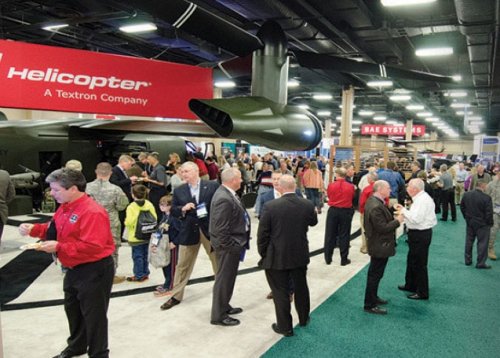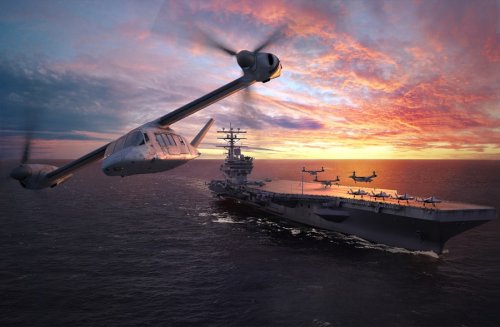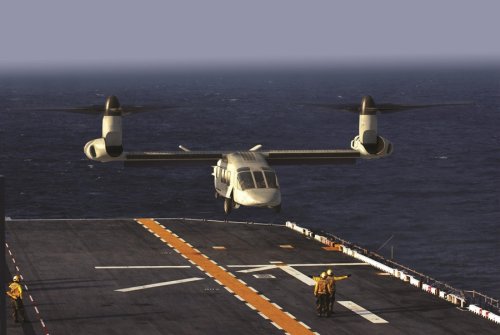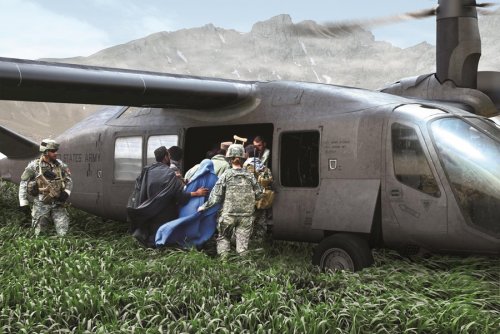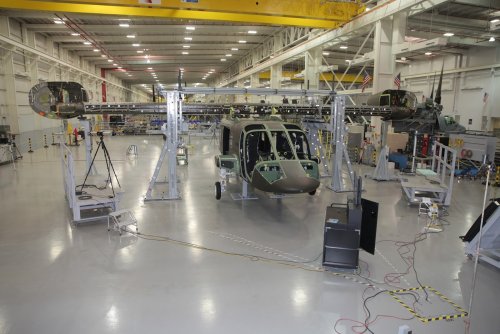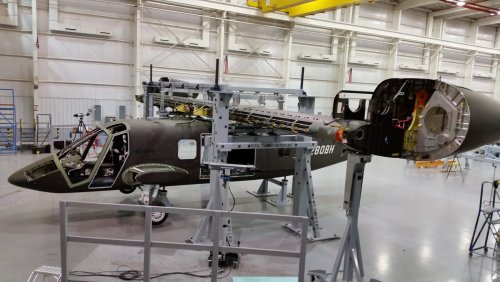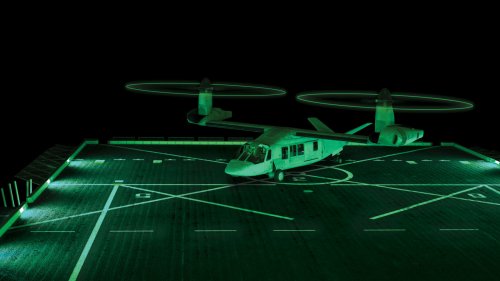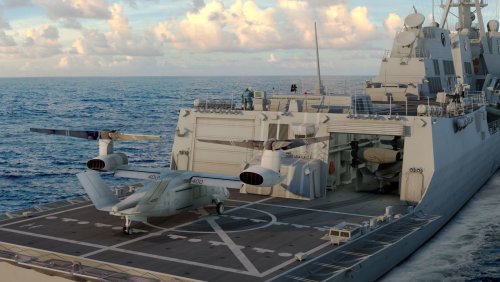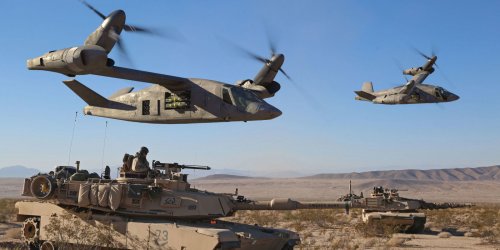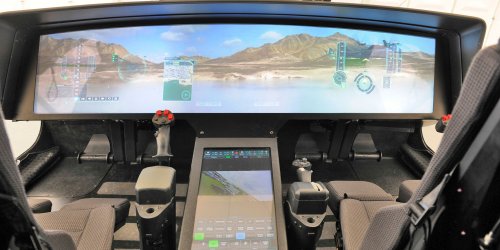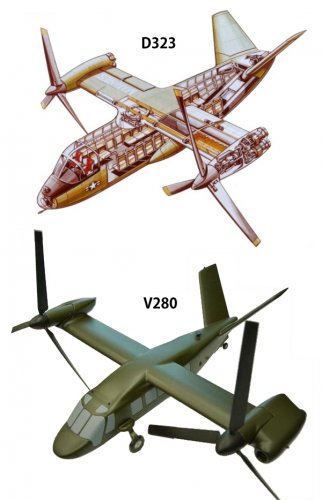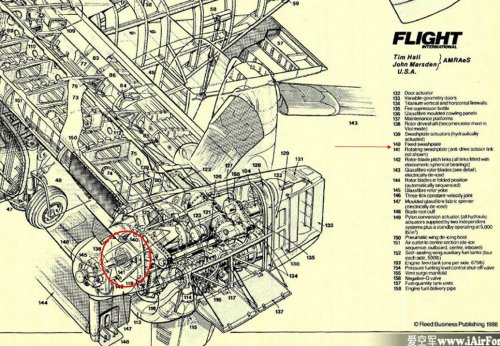Bell is continuing to work on its V-280 Valor Joint Multi Role Technology Demonstrator (JMR-TD) third generation military tiltrotor. A mock-up of the aircraft is on display here at the Farnborough International Airshow (Textron, Outside Exhibition area L2).
In April it successfully joined the wing and Israel Aircraft Industries nacelles to the Spirit AeroSystems-built fuselage at its assembly center in Amarillo, Texas. Late this fall Bell will begin installation of GE Aviation T64-GE-419 engines and main gearboxes prior to tether tests, leading up to a planned first flight in September 2017.
In an interview ahead of this week’s show, Bell Helicopter CEO Mitch Snyder argued that the V-280 is in pole position to win the U.S. military’s Future Vertical Lift Program for a next-decade to replace the Army’s Sikorsky UH-60 Black Hawks and the Bell UH-1 operated by the Marines. Bell is competing against the Boeing Sikorsky Defiant. “We have the proven technology—a straight wing with no gearboxes and the nacelles completely tilt so everything stays level,” he said. “This aircraft offers tremendous reliability and provides higher performance.”
First flight will provide Bell engineers with the data needed for the full-scale engineering, manufacturing, and development phase of the program. Concurrent to this activity, development is continuing in the company’s flight control systems lab in Fort Worth, Texas. The lab integrates pilot inputs with flight control computers and flight controls, providing data for software that works with the hardware controlling flight loads and hydraulic performance.
The V-280 includes the extensive use of monolithic honeycomb and carbon-core composite components in the fuselage, wings, tail structures, ruddervators, and the widespread use of chemical bonding in place of traditional fasteners to affix substructures. “We have improved the manufacturing processes to arrive at a revolutionary aircraft with reduced sustainment costs and simplified maintenance procedures,” said Bell executive v-p of military business development Lisa Atherton.
The JMR-TD program could involve deliveries of as many as 4,000 aircraft by the year 2030 under a contract potentially worth $100 billion. The UK’s Ministry of Defence has shown interest in the program, which will likely lead to significant foreign military sales.
Bell (Outside Exhibition L2-L5) designed the V-280 to have a cruise speed of 280 knots and a 500- to 800-nautical mile combat range with 11 to 14 troops; a 2,100-nm ferry range; a 12,000+-pound useful load; and the ability to take off in 6K/95F conditions (up to 6,000 feet pressure altitude and up to 95 degrees Fahrenheit).
Differs From V-22
It differs in design substantially for its older V-22 cousin, which has now logged more than 300,000 flight hours and is reportedly the busiest aircraft in service with the U.S. Marines. Rather than a rear ramp, it has a V-tail and two six-foot-wide sliding fuselage side doors for faster ingress/egress. Next-generation troops also will be able to wirelessly recharge their various high-tech, battery-powered gear from power sources built into the seats.
On the V-22, the engines, gearboxes and prop-rotors all rotate as thrust direction is changed; on the V-280 only the gearboxes and prop-rotors rotate. The V-280 will have 50 percent more flapping capability in its rotor system than that on the V-22, giving it greater agility in all axes.
While a final avionics configuration is still many years away, Bell is displaying a single-screen touchscreen instrument panel in the V-280 mock-up designed to use the foundation of the PDAS (pilot displayed aperture system) currently flying in the Lockheed Martin F-35 Lightning II fighter and developed by Northrup Grumman. PDAS in the F-35 provides 360-degree situational awareness by sending high-resolution real-time imagery to the pilot’s helmet from six infrared cameras mounted around the aircraft, while the system’s software prioritizes threats, and provides “data fusing.”
“The screen behaves like a tablet, with pinch, zoom and swipe capability,” explained Bell V-280 project engineer Jeremy Chavez. “This cockpit will be operational in 10-15 years. The pilots who will be flying this are eight years old today. They are growing up with smartphones and tablets, so this kind of interface would be highly intuitive for them and that is what we want to implement in the design. We want them to be able to absorb as much information as they can, but display it in an intuitive way that is aiding the flight—not going through subsystem after subsystem to locate the information, but having it where you need it, when you need it; and then you close it out when you don’t need it.”
The screen itself would be constructed from a series of small “plug and play” display modules that fit together into one giant mosaic, thus insulating the whole system from failure in the event of a ballistic impact or other cause. Data from a dead module would automatically transfer to the live part of the mosaic, ensuring no data was lost. “If you take a ballistic impact, 95 percent of the screen is still intact,” Chavez said, while admitting that Bell engineers have a way to go before the system is ready to fly. “But we’re very excited,” he said.






